Kentucky Coffeetree I: A Rare Species
Of all the trees in our native sylva, Kentucky coffeetree is probably the least familiar and the most misunderstood. So let’s take a quick review and attempt to tidy up some of the facts and mythology.
Like so much of our local native flora and fauna, Kentucky coffeetree has the core of its native range to the southeast of us.
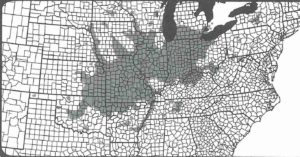
The native distribution of Kentucky coffeetree
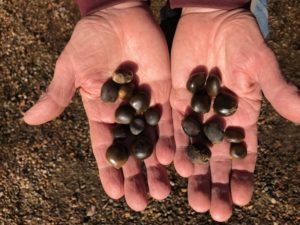
A handful of the seeds.
The growth form of this species when mature is one of sparse but stout branches on a stocky trunk, in winter reminding me of a muscular black walnut. In summer it has enormous airy pinnate leaves, which cast thin shade and look similar to its close cousin, the honey locust. Much of the year the female trees also bear large flat brown leathery pods, rather like giant lima beans. When seen from a distance in winter, the pods resemble a flock of birds in the tree. Within each pod, the large seeds are also reminiscent of lima beans, which is not surprising because both are legumes. The seeds are embedded in a sorta sweet and sticky bright green gel.
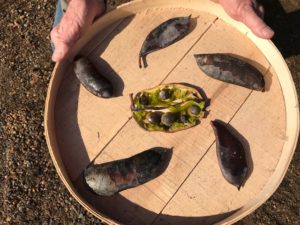
A handful of the pods, one opened to show the seeds embedded in green gel.
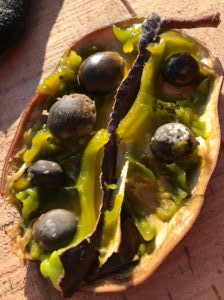
Closeup of pod and green gel.
Within its distribution, nowhere is it abundant; there are always just a few scattered across the landscape. The extensions of its range are mostly upstream or downstream along the larger rivers. At least one book claims that Indians liked to eat the sweet green gel and therefore planted seed along their canoe routes. This is unlikely because the gel is sorta toxic to people, with unpleasant consequences if you eat much of it, and the Indians would have figured this out as soon as they arrived on this landscape.
In fact, the entire tree is somewhat toxic – leaves, bark, wood, seeds, and green gel. The main toxin is probably an alkaloid, and many plants produce alkaloids for their protection, including some of our favorites like nicotine, caffeine, and cocaine. But like so many aspects of this uncommon tree, it remains poorly studied and facts get mingled with folklore. Pammel includes the species in his A Manual of Poisonous Plants. One book claims that autumn leaves from this species polluted a puddle and killed cattle drinking from it. So I wouldn’t be surprised to learn that the smoke from the burning wood should also be avoided.
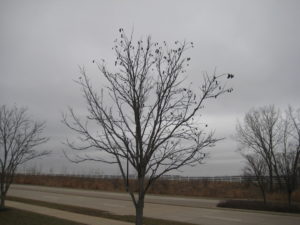
A young female with seed pods, along First Avenue.
I’ve met people who claim that they have eaten the green gel without consequences, but I don’t believe it. Its close cousin, the honey locust, also has large pods with large seeds in a green gel, which is sweet but non-toxic. And I think part of the conflicting claims derive from confusion between the two species.
If you wish to get field-familiar with Kentucky coffeetree and its unique bark and pods, the City of Coralville is growing two blocks worth as sidewalk trees along First Avenue, just north of I-80, beside Oak Hill Cemetery and the Firefighters Memorial. The female trees have the large pods lingering well into winter, but otherwise look much like the males.
This is one of the most unique and rare native trees you can grow – if you have the space – and the toxicity is acceptable. To grow, the impermeable seed coat needs to be breached, and for just a few seeds a little workout with sandpaper or nicking with a file will suffice.
Next week we will consider the coffee question.
Tags: Kentucky coffeetree, Lon Drake, native tree

